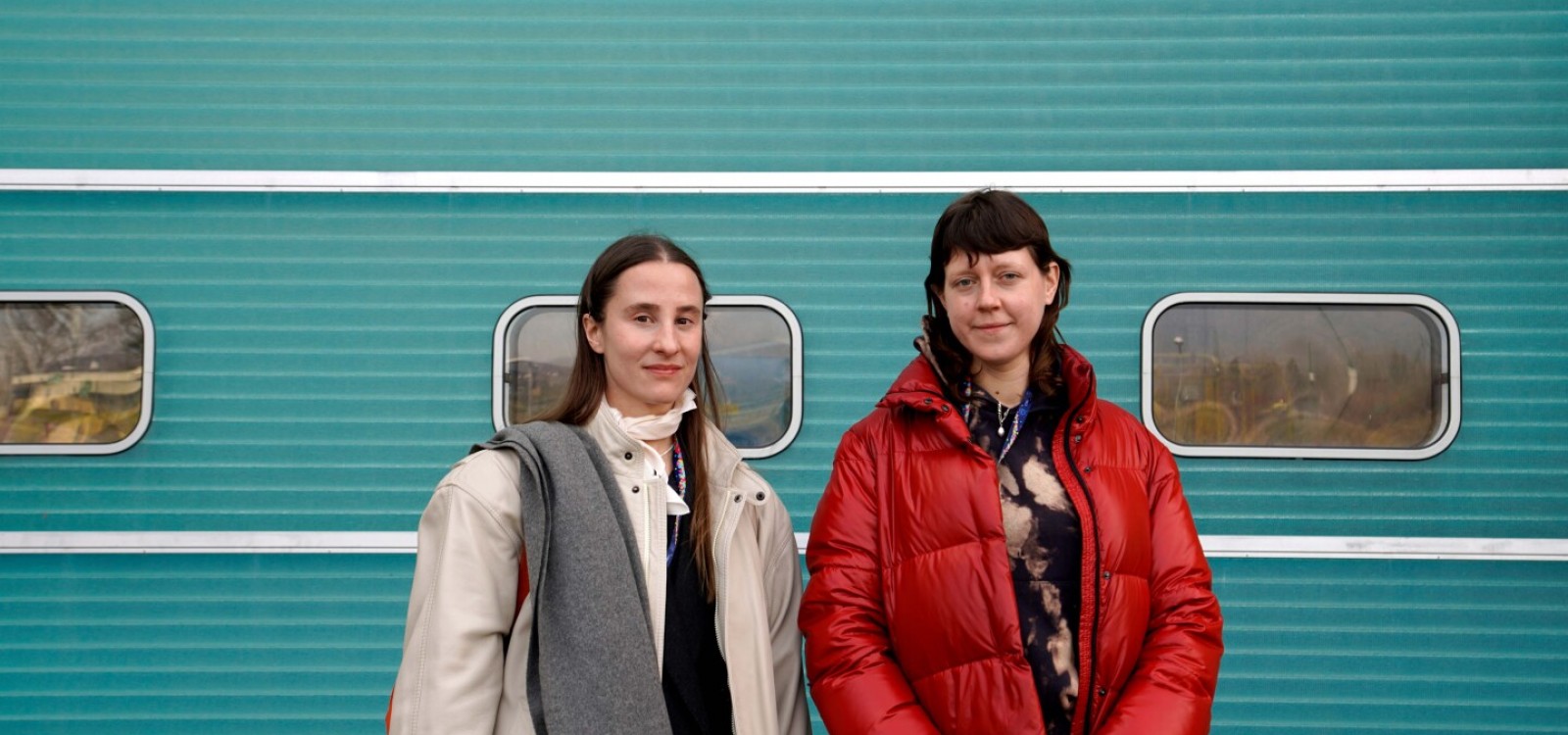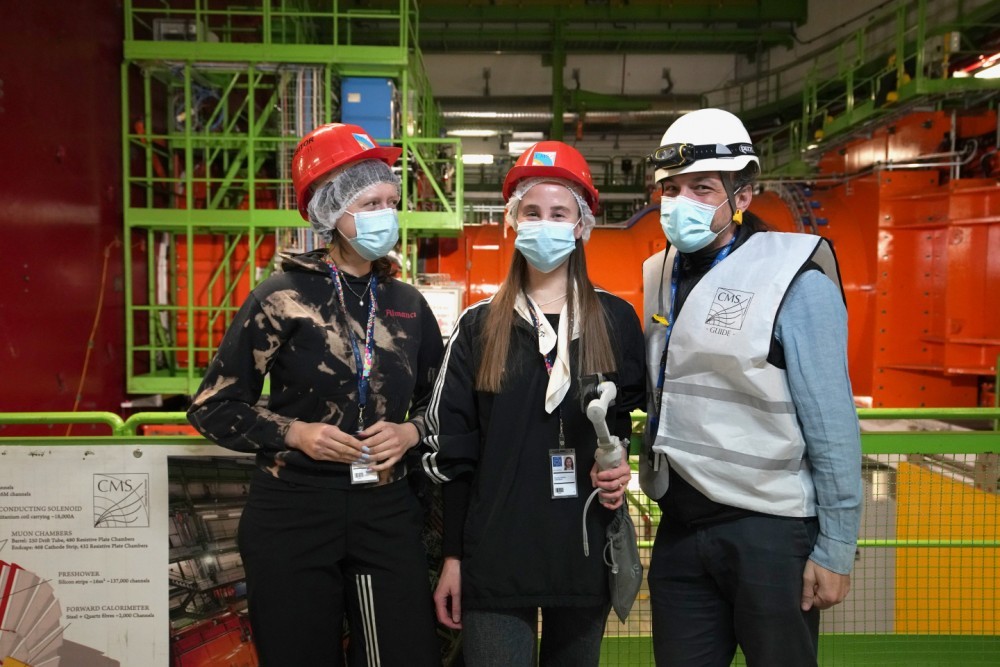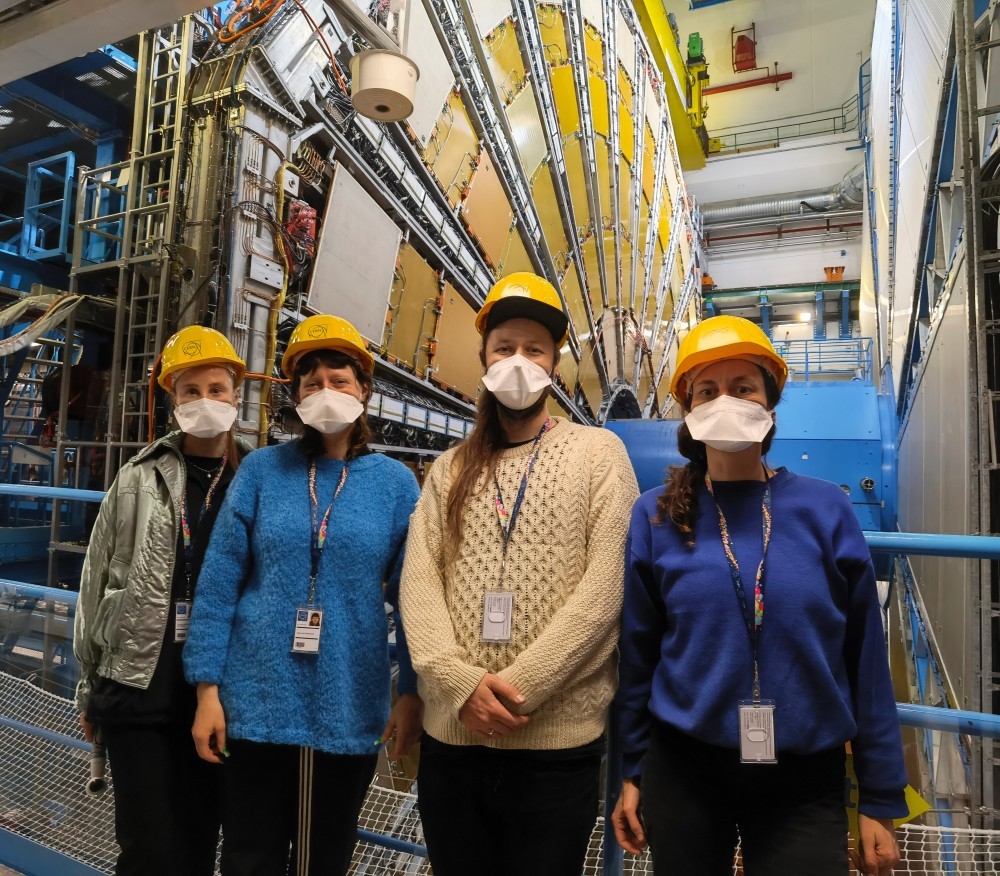
Dorota Gaweda and Egle Kulbokaite start their residency at CERN
The Basel-based artist duo starts their residency at the Laboratory as the winners of the last Collide Award. We spoke with the artists about their interest in quantum physics, their residency project Gusla, and how they approach weirdness in their work.
How did your interest in quantum physics come about?
In our collaborative practice, we investigate the blurring boundaries and look into the unknown, aiming at challenging the illusory promise of subjectivity as a whole and separate from the environment, which is individually perceived and societally imagined. We aim to tackle the fragility of dichotomies and underline the porosity of the constructs that build our customary understanding of the world. We are interested in the alternate narratives of world-building that (science) fiction, folktales and fables could offer us. We see that the concepts and theories of physics serve as one such narrative construction tools. Our interest in particle physics derives from our continuous reading into (eco-)feminist and queer theory, specifically of writers such as Luciana Parisi and Denise Ferreira da Silva with their specific emphasis on the liberatory potential of quantum physics can offer for thoughts and social relationships. In her writing, in particular, Denise Ferreira da Silva calls for quantum unlearning, a deep questioning that quantum physics demands from us: through physics, we discover that the universe does not respect our intuitive notions about subjectivity, objectivity, knowability, categorisation, and even existence itself. We are further interested in how quantum physics, in particular, introduced an instability of knowledge into the scientific world and how it opened up the scientific vocabulary to certain traits of weirdness and even magic. We hope that the engagement with quantum mechanics has the potential to break normative patterns of human behaviour and negotiate new ways of relating to the natural world to find new patterns. Our project will look for queer relationships between particles, beings and thoughts.
Your Collide-winning proposal, Gusła, is inspired by how quantum physics exposes the ‘weirdness’ of the living world. Weirdness has also played an important in the narrative of some of your recent works, such as in Mouthless Part I (2020) and Part II (2021). How do you approach ‘weirdness’ in your work?
Our proposed project Gusła is, in a sense, a continuation of our video series Mouthless, two parts of it finished and the third currently in production. The videos aim to consider a number of urgencies we see as intertwined into the ecology of landscape, including primitive accumulation; histories of European deforestation; eco-feminist theory; folkloric undead beings originating in Slavic and Baltic cultures connected to the soil, swamp and terrestrial waters; and historic redefinition of the relation of the individual and the land. In our work, weirdness permeates both in content and form; a montage or conjoining of two or more references, aesthetics or concepts that seemingly do not go together is meant to destabilise the certainty of the sense of knowing. Wet like moss, it seeps into crevices of written texts, into the cracks of history and flourishes in the comforting darkness, intricately organic.
Mouthless Part I (2020) was created in the time we have been developing our solo exhibition at the Fri Art - Kunsthalle Fribourg in Switzerland. The video, thus, lifts the stories from the region’s history, specifically those of European witch persecution, quoting the historical records of the magistrate court in the city of Fribourg. One of the records directly quoted in the film as a voiceover, appearing over the ever transforming GAN landscapes, is that of Barbli Bodmer of Wattenwyll accused of promiscuity and fornication with the devil in the forest. Under torture Bodmer confesses to the use of ointment, the making of a pact with the devil, the poisoning of water and apples, causing illness in humans and farm animals. Her trial and confession are rich in testimony of various people and graphic description of sexual acts with beasts and the devil. Bodmer was executed for witchcraft in 1637. Mouthless Part I weaves this and other historical events into the weird narrative inspired by the framework of the Slavic and Baltic traditions of calling forth the dead to reinhabit the spaces of the living. While making Mouthless Part I, we were thinking of out loud reading as conjuring, of agency of finding voice and speaking out loud, as well as a potentiality of an artwork to call forth the unseen and unheard stories. At the centre of the film, the viewer finds a family that performs a number of arbitrary ritual gestures. Rather casual but yet slightly uncanny, the actions are modelled after the Eastern European tradition of cyclically calling back the dead to reinhabit the spaces of the living. These rituals are there to conjure the voices of the unheard, whether the dead victims of the historical witch persecutions of Europe and the colonised lands or the depleted forests.
Mouthless Part II (2021) is structured around a song, inspired by the Lithuanian sutartinė folk singing where traditionally three (or more) singers perform a looping text which becomes chant and texture, a sort of carrier of arcane information. Our song modelled after this tradition, quotes theory and poetry in equal measures. It is the basis for interpretation, embodiment and improvisation for the actors that lip-sync to the alien and otherworldly voices. On the three screens, we see three figures performing the plaintive lament in front of sometimes surreal, artificial, fog-shrouded landscapes. With Mouthless Part II, we are thinking through queer ecology and recalling rituals connected to mourning, death and the threshold. A particularly important reference in this work is Timothy Morton’s Dark Ecology. The script of the piece speaks both of the historical redefinition of the relation of the individual and the land and the contemporary complexity of the overhanging ecological drama. Mouthless Part II is a type of mourning - lament that is sung backwards over and over. This repetition not only points out the absurdities and weirdness of everyday life in the face of the global crisis and mass extinction but also represents a proposal to think about time, indeed existence itself, in loops and cycles. The video imagines a situation in which demons fluid in their gender and speaking in tongues are called into a world without a separation of past, present and future, the human and non-human, the technological and natural forces, the living and the dead.
Can you introduce us to what you seek to explore and research during your time at CERN and Barcelona?
We have started the residency with an aim to develop a sci-fi folk narrative of quantum summonings. Gusła will call forth the Slavic demons of the swamps, and forest edges - the characters that live in-between and tempt people beyond the line of safety. The conjuring narrative will serve as a loose connecting thread for a series of video works and a body of sculptural environments and objects to be performatively activated. With the scriptwriting composed of the multiplicity of citations, we hope to reference the concepts of physics and allude to our extended reading list, where (eco-) feminist and queer theory meets science fiction, performed and embodied in unexpected ways whether through song, chant or out-loud reading. As part of CERN Collide Residency programme, we hope to first and foremost engage with the scientific community at CERN and to find out more about theories and concepts in order to think of future potentials for the structures of narration.
The artists that come to CERN bring different approaches, and the dynamics between artists and scientists follow unexpected paths. What do you expect from your time in the laboratories and your exchanges with the scientific communities?
We commenced our residency with underground trips to the ATLAS and CMS experiments, lucky enough to be able to visit in March and April 2022 before the sites shut for the coming years of research. This in itself was an incredible experience of an underworld only seldom accessible, alike in mythological tales; but also vastly different to the fables that typically inspired our practice. The ritual of descending, the aesthetic dimension of the environments and the grandeur and the technological complexity of machinery used in the experiments leaves one with the feeling of having insufficient tools for complete understanding. After the first week of talking to the scientists, we find it fascinating how science functions under the premise of collective endeavour beyond individual lifespan. A week into the Collide Residency at CERN, we understand that it is the best to step into this world with an open mind. We are aiming to understand how weirdness enters the world of particle physics both in language (i.e. the introduction of nomenclature such as strange quark) and the processes of experimenal research. Already in our first week at CERN, we have also had challenging conversations with the theoretical physicists Michelangelo Mangano and John Ellis, which opened up to us about such theories as the Violation of Parity by Chien-Shiung Wu. Our approach to the residency is to take in as much as possible during the month of May that we can conceptualise and concretise into the body of production for the month at Hangar Centre for Art Research and Production in Barcelona in November and our final month at CERN the following year.
You have also explored the mechanisms of circulation of knowledge, from traditions of orality transmission, rituality and written sources, and manifested through different media, such as in your series of performances SULK and in your scent RYXPER1126AE (2018). What role does storytelling play in your practice? How does it relate to your use of different media?
We aim to use tools that speculate on possibilities of a different relationship to the environment. We believe that stories can also be told through a multiplicity of voices and also experienced bodily - as a proposition for alternate ways of thinking about the surrounding world. We introduce into our practice a variety of narratives and media to allow multiple entryways to the work. With RYXPER1126AE (2018), for example, we employ smell to underline that the boundaries between public and private, internal and external, self and environments have always been permeable. At the 6th Athens Biennial we presented the first iteration of the SULK performance series, SULK I (2018), during which the fragrance RYXPER1126AE was conceived in collaboration with International Flavors and Fragrances Inc. (New York). Together with a chemist, perfumer and smell designer from IFF Inc. we produced a synthetic molecular replica of the smell collected with the use of headspace technology during the performance. This smell bears a poetic sign or memory of belonging to a collective experience, a sentiment to a shared moment. With the use of smell we aim for these temporary spaces of intimacy; we eploy scent within our exhibitions unbottled and dissolving, creating the moment the audience and performers can share. We were interested in treating smell as an olfactory method of documentation of both performance and space as well as the role of scent as an interface which creates a volatile passage between the virtual dimension and the physical body.
We think of smell as a performative play on the molecular level, thinking through Paul B. Preciado’s Testo Junkie and underlining the breaking boundaries between us, the other and nature, flowing through and across humans and machines, life-forms and non-life-forms. In collaboration with IFF Inc., we also more recently created a scent work titled A Large Piece of Turf 02:60 (2020). Referencing the title of Albrecht Dürer’s botanical watercolour from 1503, the work suggests the porous relationship between the self and the natural world and offers the olfactory as a form of representing this complexity. Here, an industrial diffuser emits an earthy and sweet yet synthetic fragrance of petrichor, the scent of raindrops falling on dry soil. The smell of wet soil is known to stimulate a visceral response in people and to call forth distant memories. It is the molecular moment of the landscape entering the breathing body. We are particularly interested in smell as an engulfing spatial experience and collective memory and attempt to consider the olfactory when thinking about our sculptural work as well.
Another work of ours titled Hexanol (2019) also opens up to the viewer only when experienced in the exhibition space. In its form, the Hexanol sculpture is a pole carefully dressed in meadow hay, gathered together in a shape traditionally used by field workers. When experienced in the exhibition space, the sculpture often draws on the viewer’s idyllic memory of childhood. The title of our work Hexanol references the molecule cis-3-Hexen-1-ol that is responsible for what we perceive simultaneously as the smell of cut grass and that of old books. It is the smell of decomposing cellulose. The heap of hay is oddly similar in size to a human figure. The pile is held by an austere looking, polished stainless-steel or aluminium pole that eerily culminates in a sharp dagger form. The shape itself may suggest a pyre or a burning stake. The layering of those references tells multiple stories at once and it's precisely this layering that interests us the most.
Collide is Arts at CERN's international residency programme, in collaboration with the city of Barcelona (2019-2021).
Interview by Ana Prendes. Communications and Content Producer at Arts at CERN



